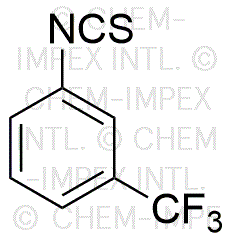3-(Trifluoromethyl)phenyl isothiocyanate is widely utilized in research focused on:
- Pharmaceutical Development: This compound serves as a key intermediate in the synthesis of various pharmaceuticals, particularly those targeting cancer and inflammatory diseases, enhancing drug efficacy through its unique chemical properties.
- Agricultural Chemistry: It is used in the formulation of agrochemicals, including herbicides and fungicides, providing effective solutions for pest control while minimizing environmental impact.
- Material Science: The compound is incorporated into polymers and coatings, improving their thermal stability and resistance to chemical degradation, which is crucial for industrial applications.
- Analytical Chemistry: It acts as a reagent in various analytical techniques, aiding in the detection and quantification of specific compounds in complex mixtures, thus streamlining research processes.
- Biochemical Research: This isothiocyanate is used in studies related to enzyme inhibition and cellular signaling pathways, contributing to a better understanding of biological mechanisms and potential therapeutic targets.
Información general
Propiedades
Seguridad y normativas
Aplicaciones
3-(Trifluoromethyl)phenyl isothiocyanate is widely utilized in research focused on:
- Pharmaceutical Development: This compound serves as a key intermediate in the synthesis of various pharmaceuticals, particularly those targeting cancer and inflammatory diseases, enhancing drug efficacy through its unique chemical properties.
- Agricultural Chemistry: It is used in the formulation of agrochemicals, including herbicides and fungicides, providing effective solutions for pest control while minimizing environmental impact.
- Material Science: The compound is incorporated into polymers and coatings, improving their thermal stability and resistance to chemical degradation, which is crucial for industrial applications.
- Analytical Chemistry: It acts as a reagent in various analytical techniques, aiding in the detection and quantification of specific compounds in complex mixtures, thus streamlining research processes.
- Biochemical Research: This isothiocyanate is used in studies related to enzyme inhibition and cellular signaling pathways, contributing to a better understanding of biological mechanisms and potential therapeutic targets.
Documentos
Hojas de datos de seguridad (HDS)
La SDS proporciona información de seguridad completa sobre la manipulación, el almacenamiento y la eliminación del producto.
Especificación del producto (PS)
La PS proporciona un desglose completo de las propiedades del producto, incluida la composición química, el estado físico, la pureza y los requisitos de almacenamiento. También detalla los rangos de calidad aceptables y las aplicaciones previstas del producto.
Certificados de análisis (COA)
Busque certificados de análisis (COA) ingresando el número de lote del producto. Los números de lote y de partida se pueden encontrar en la etiqueta de un producto después de las palabras "Lote" o "Lote".
Número de catálogo
Número de lote/lote
Certificados de origen (COO)
Este certificado de origen confirma el país en el que se fabricó el producto y también detalla los materiales y componentes utilizados en él y si se deriva de fuentes naturales, sintéticas u otras fuentes específicas. Este certificado puede ser necesario para cumplir con las normativas aduaneras, comerciales y regulatorias.
Número de catálogo
Número de lote/lote
Hojas de datos de seguridad (HDS)
La SDS proporciona información de seguridad completa sobre la manipulación, el almacenamiento y la eliminación del producto.
DownloadEspecificación del producto (PS)
La PS proporciona un desglose completo de las propiedades del producto, incluida la composición química, el estado físico, la pureza y los requisitos de almacenamiento. También detalla los rangos de calidad aceptables y las aplicaciones previstas del producto.
DownloadCertificados de análisis (COA)
Busque certificados de análisis (COA) ingresando el número de lote del producto. Los números de lote y de partida se pueden encontrar en la etiqueta de un producto después de las palabras "Lote" o "Lote".
Número de catálogo
Número de lote/lote
Certificados de origen (COO)
Este certificado de origen confirma el país en el que se fabricó el producto y también detalla los materiales y componentes utilizados en él y si se deriva de fuentes naturales, sintéticas u otras fuentes específicas. Este certificado puede ser necesario para cumplir con las normativas aduaneras, comerciales y regulatorias.


